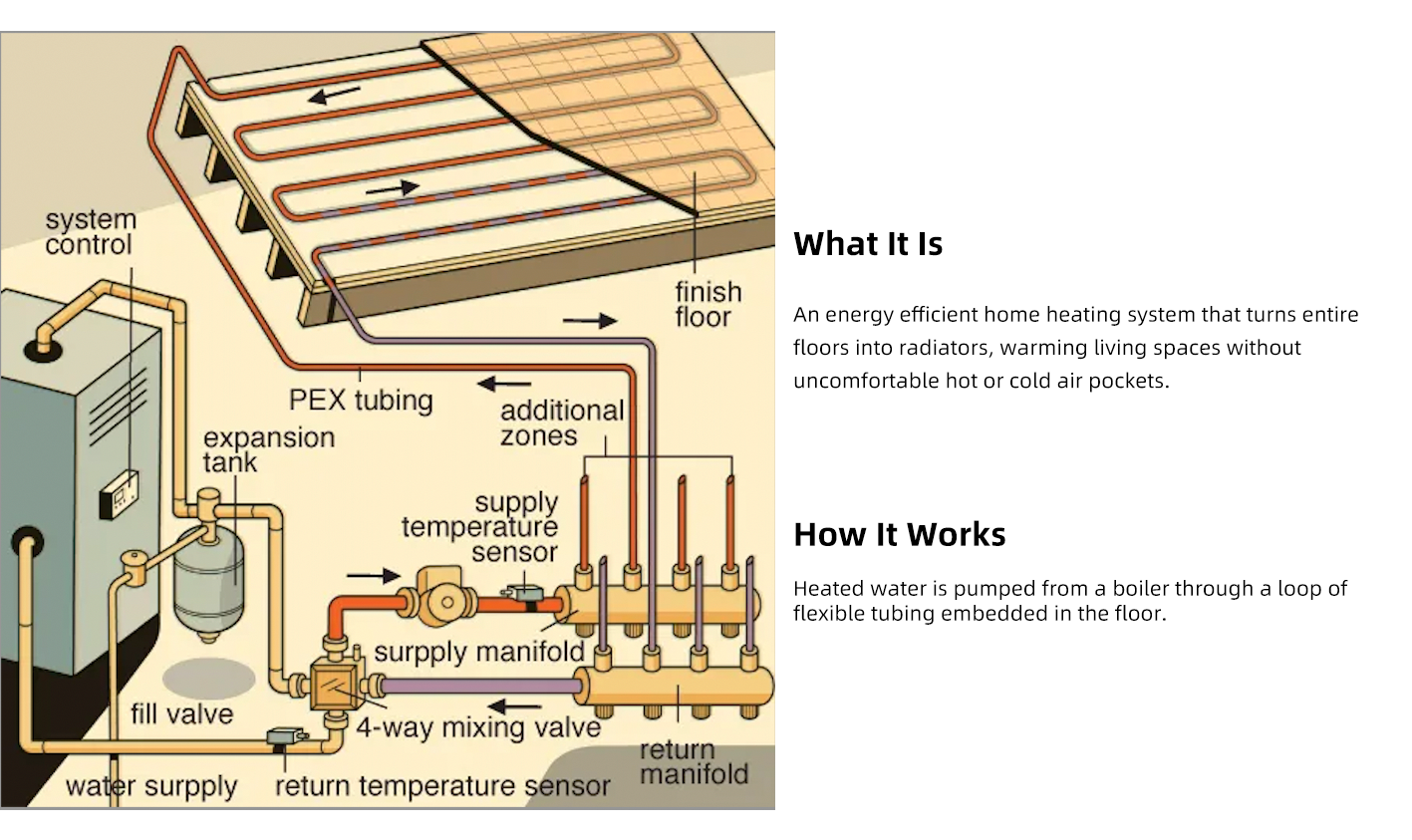The Single Strategy To Use For Radiant Heating Systems
Table of ContentsSome Known Incorrect Statements About Radiant Heating Systems The Main Principles Of Radiant Heating Systems The Definitive Guide for Radiant Heating SystemsThe Main Principles Of Radiant Heating Systems More About Radiant Heating Systems
Glowing heating systems supply warm straight to the floor or to panels in the wall surface or ceiling of a house. The systems depend mainly on convected heat transfer-- the shipment of warm straight from the warm surface to individuals as well as objects in the area through infrared radiation. Radiant heat is the impact you really feel from the heat of a hot stovetop aspect from throughout the area.
Individuals with allergic reactions often prefer radiant warm since it doesn't distribute allergens like forced air systems can. Hydronic (liquid-based) systems make use of little electrical energy, an advantage for homes off the power grid or in areas with high power costs.
For more on the various kinds of power sources and warm distribution systems for house heating, explore our Energy Saver 101 infographic on residence heating. Regardless of its name, glowing floor heating depends greatly on convection, the all-natural circulation of heat within an area as air heated by the floor climbs.
Some Known Details About Radiant Heating Systems
Consequently, the adhering to areas review radiant flooring warm and radiant panels separately. There are three kinds of radiant floor warmth-- glowing air floorings (air is the heat-carrying medium), electric radiant floors, as well as warm water (hydronic) radiant floorings. You can even more categorize these kinds by installation. Those that make use of the big thermal mass of a concrete piece flooring or lightweight concrete over a wood subfloor are called "wet installments," and those in which the installer "sandwiches" the glowing flooring tubing in between two layers of plywood or attaches the tubing under the finished flooring or subfloor are called "completely dry installments." Air can not hold big amounts of heat, so radiant air floors are not cost-efficient in residential applications, and also are rarely mounted.
The inefficiency of attempting to warm a home with a conventional furnace by pumping air via the floorings at evening outweighs the benefits of using solar warmth during the day. Although some early solar air heating unit utilized rocks as a heat-storage tool, this strategy is not advised (see solar air home heating systems).
Systems that feature electric matting placed on the subfloor below a flooring covering such as ceramic tile are likewise readily available. As a result of the fairly high expense of electricity, electric glowing floors are normally just economical if they consist of a substantial thermal mass such as a thick concrete floor as well as your electrical energy business uses time-of-use rates.
The Ultimate Guide To Radiant Heating Systems
m. to 6 a. m.). If the flooring's thermal mass is large enough, the heat kept in it will certainly maintain the residence comfy for eight to 10 hours with no more electrical input, specifically when daytime temperature levels are considerably warmer than nighttime temperature levels. This saves a substantial amount of cash contrasted to heating at peak electric prices throughout the day.
Property owners should check out various other alternatives, such as mini-split warm pumps, which run a lot more successfully and have actually the added advantage of providing cooling. Hydronic (fluid) hop over to here systems are the most prominent and cost-effective radiant heating systems for heating-dominated climates. Hydronic glowing floor systems pump warmed water from a boiler through tubing stocked a pattern under the floor.
The cost of mounting a hydronic glowing flooring differs by location as well as depends on the dimension of the residence, the type of setup, the flooring covering, seclusion of the useful source website, as well as the cost of labor. Whether you use home heating cables or tubing, the techniques of mounting electrical as well as hydronic glowing systems in floors are comparable.
About Radiant Heating Systems
The tubing or cable can be installed in a thick concrete structure slab (frequently made use of in "piece" ranch residences that do not have cellars) or in a slim layer of concrete, gypsum, or various other product installed on top of a subfloor. If concrete is utilized and the new floor is out solid earth, additional floor support may be essential as a result of the included weight. Radiant heating systems.

Due to the fact that dry floors entail heating an air room, the radiant home heating system needs to operate at a higher temperature. This approach generally needs exploration through the flooring joists to install the tubes.
The Radiant Heating Systems Ideas
In these circumstances, liquid tubing is anonymous often fitted into aluminum diffusers that spread out the water's warmth throughout the flooring in order to heat up the flooring much more evenly. The tubes and also warmth diffusers are protected in between furring strips, which carry the weight of the new subfloor and completed floor surface area. A minimum of one business has enhanced this idea by making a plywood subfloor material produced with tubing grooves and also light weight aluminum warm diffuser plates constructed into them.
If some areas, however not all, have a floor covering, after that those spaces ought to have a different tubes loop to make the system heat these spaces extra efficiently. This is due to the fact that the water streaming under the protected flooring will require to be hotter to make up for the flooring covering. Timber flooring must be laminated wood flooring rather than strong timber to minimize the opportunity of the timber diminishing as well as cracking from the drying out impacts of the warmth.